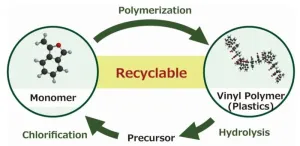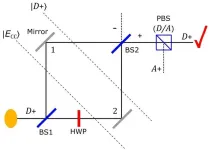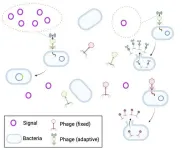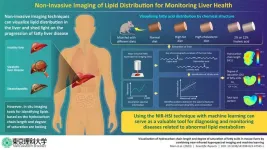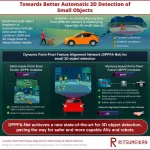(Press-News.org) CORVALLIS, Ore. – An international team of scientists led by Oregon State University researchers has used a novel 500-year dataset to frame a “restorative” pathway through which humanity can avoid the worst ecological and social outcomes of climate change.
In addition to charting a possible new course for society, the researchers say their “paradigm shifting” plan can support climate modeling and discussion by providing a set of actions that strongly emphasize social and economic justice as well as environmental sustainability.
Oregon State’s William Ripple, former OSU postdoctoral researcher Christopher Wolf and collaborators argue their scenario should be included in climate models along with the five “shared socioeconomic pathways,” or SSPs, that are used by the U.N.’s Intergovernmental Panel on Climate Change.
“We understand that our proposed scenario may be a major challenge to implement given current trends in emissions, a lack of political will and widespread social denial, but its merits can’t even be honestly debated if it’s not included in the suite of options,” said Ripple, distinguished professor of ecology in the OSU College of Forestry. “We’re arguing for radical incrementalism: achieving massive change through small, short-term steps. And we’re offering a much-needed contrast to many other climate scenarios, which may be more aligned with the status quo, which isn’t working.”
Ripple and co-authors from the United States, the Netherlands and Australia present their restorative pathway in a paper published today in Environmental Research Letters. They say the pathway is inspired by a unique compilation of Earth system variables that vividly illustrate how humanity’s resource demands have exploded since 1850, indicating ecological overshoot.
“The supporting data underscore the urgent need for action,” said Wolf, now a scientist with Corvallis-based Terrestrial Ecosystems Research Associates. “The growth in human population, gross domestic product and energy consumption, primarily reliant on fossil fuels, has led to an extraordinary surge in greenhouse gas emissions, dramatically altering land use and triggering a massive biodiversity decline.”
The authors note that current climate change modeling relies on multiple assumptions and factors related to policy options and societal developments. An international team of climate scientists, economists and energy systems modelers developed the SSPs, which are used to derive greenhouse gas emissions scenarios under different sets of policies that assume continued and significant GDP growth through 2100.
“The SSPs describe plausible developments that in the future would lead to different challenges for climate change mitigation and adaptation,” Wolf said. “They’re based on five narratives that describe alternative socioeconomic developments, some more sustainable than others. Our scenario focuses on reducing the consumption of primary resources to a level that keeps environmental pressures within planetary boundaries, with per capita GDP stabilizing over time.”
Wolf, Ripple and collaborators took a long-term look back at a range of variables: fossil fuel emissions, human population, GDP, land use, greenhouse gas concentrations, global temperature, vertebrate wildlife species abundance, income inequality and meat production.
Collectively, the data paint a comprehensive picture of the profound changes Earth has undergone, say the authors, who include Jillian Gregg of Terrestrial Ecosystems Research Associates, Detlef P. van Vuuren with the Netherlands Environmental Assessment Agency and Manfred Lenzen of the University of Sydney.
“The income share variable extends back to 1820 and shows how the top 10% have consistently received at least 50% of all income, illustrating global economic inequality over the long term,” Ripple said. “The restorative pathway would represent a more equitable and resilient world with a focus on nature preservation as a natural climate solution; societal well-being and quality of life; equality and high levels of education for girls and women, resulting in low fertility rates and higher standards of living; and a rapid transition toward renewable energy.”
Unlike some of the current shared socioeconomic pathways, the restorative pathway does not rely on the development of carbon capture technologies, nor does it assume continued economic growth as the SSPs do.
“By prioritizing large-scale societal change, our proposed pathway could limit warming much more effectively than pathways that support rising resource consumption by wealthy nations,” Ripple said. “We aim to bend the curves on a wide range of planetary vital signs with a holistic vision for addressing climate change, biodiversity loss and socioeconomic injustice. Our work presents a case for how humanity can embark on the journey of saving the world from these environmental and social crises.”
In October 2023, Ripple, Wolf and 10 other U.S. and global scientists published research in BioScience that showed the Earth’s vital signs have worsened beyond anything humans have yet seen, to the point that life on the planet is imperiled.
Ripple is also the co-author of another BioScience paper, published today, that examines climate change and the related biodiversity crisis from a cosmic perspective using “long-term planetary thinking,” he said.
END
Scientists outline a bold solution to climate change, biodiversity loss, social injustice
2024-01-09
ELSE PRESS RELEASES FROM THIS DATE:
Novel chemical recycling system for vinyl polymers of cyclic styrene derivatives
2024-01-09
Chemical recycling of widely used vinyl polymers (VPs) is one of the key technologies required for realizing a sustainable society. In this regard, a team of researchers from Shinshu University have recently reported a new chemical process that facilitates the depolymerization of cyclic styrene-based VPs, resulting in the recovery of a monomer precursor. This highly efficient chemical recycling system can help with effective resource circulation and the development of new plastic recycling technologies.
Vinyl polymers (VPs) are ...
Quantum particles can’t separate from their properties, after all
2024-01-09
The quantum Cheshire cat effect draws its name from the fictional Cheshire Cat in the Alice in Wonderland story. That cat was able to disappear, leaving only its grin behind. Similarly, in a 2013 paper, researchers claimed quantum particles are able to separate from their properties, with the properties travelling along paths the particle cannot. They named this the quantum Cheshire cat effect. Researchers since have claimed to extend this further, swapping disembodied properties between particles, disembodying multiple properties simultaneously, ...
Press passes now available for Discover BMB to be held March 23–26
2024-01-09
Complimentary press passes are now available for Discover BMB, the annual meeting of the American Society for Biochemistry and Molecular Biology (ASBMB). Join us March 23–26 in San Antonio to experience an engaging agenda showcasing the newest developments and current trends in the field.
As the flagship meeting for one of the largest molecular life science organizations in the world, #DiscoverBMB brings together researchers in academia and industry from across the globe.
Explore captivating science stories and connect with leading experts during the scientific symposia, which will encompass 12 themes. Topics include:
Exciting ...
New CRISPR Center brings hope for rare and deadly genetic diseases
2024-01-09
Children and adults with rare, deadly genetic diseases have fresh hope for curative therapies, thanks to a new collaboration between the Innovative Genomics Institute (IGI) and Danaher Corporation, a global life sciences and diagnostics innovator.
The new Danaher-IGI Beacon for CRISPR Cures center will use genome editing to address potentially hundreds of diseases, including rare genetic disorders that have no cure. The goal is to ensure treatments can be developed and brought to patients ...
Three researchers awarded $1 million each to study new heart disease treatments, causes
2024-01-09
DALLAS, Jan. 9, 2024 — A physician-scientist from Massachusetts researching whether chemicals naturally occurring in foods could help treat heart disease, a genetics expert from Pennsylvania exploring the molecular mechanisms of lipid metabolism and cardiovascular diseases and a California-based professor of cardiovascular medicine studying how vaping impacts the development of abdominal aortic aneurysms are the most recent American Heart Association Merit Award recipients. Over the next five years, each researcher will receive a total of $1 million in funding from the Association, the world’s leading voluntary organization focused on heart and brain health and research, ...
The value of information gathering for phages
2024-01-09
Phages, the viruses that infect bacteria, will pay a high growth-rate cost to access environmental information that can help them choose which lifecycle to pursue, according to a study. Yigal Meir and colleagues developed a model of a bacteria-phage system to investigate how much the viruses should be willing to invest to acquire information about their local environment. A temperate phage, once inside a bacterium, can choose one of two life cycles. In the lytic cycle, the phage turns the bacterium ...
Protecting newborns: Research lays the groundwork for a lifesaving vaccine
2024-01-09
BINGHAMTON, N.Y. -- Researchers from Binghamton University, State University of New York are unraveling the workings of Group B Strep (GBS) infections in pregnant women, which could someday lead to a vaccine.
One in five pregnant women carry Streptococcus agalactiae (Group B Strep or GBS) in the vaginal tract, which is typically harmless — except when it isn’t.
The bacterial infection poses serious and even fatal consequences for newborns, including pneumonia, sepsis and meningitis, which can have long-term effects on the child’s cognitive function.
Researchers ...
New study unveils machine learning-aided non-invasive imaging for rapid liver fat visualization
2024-01-09
Steatotic liver disease (SLD), previously known as non-alcoholic fatty liver disease, which includes a range of conditions caused by fat build-up in the liver due to abnormal lipid metabolism, affects about 25% of the population worldwide, making it the most common liver disorder. Often referred to as “silent liver disease,” SLD progresses without noticeable symptoms and can lead to more severe conditions like cirrhosis (liver scarring) and liver cancer.
A liver biopsy—an invasive procedure involving liver tissue sample extraction from the body—is ...
Towards more accurate 3D object detection for robots and self-driving cars
2024-01-09
Robotics and autonomous vehicles are among the most rapidly growing domains in the technological landscape, with the potential to make work and transportation safer and more efficient. Since both robots and self-driving cars need to accurately perceive their surroundings, 3D object detection methods are an active area of study. Most 3D object detection methods employ LiDAR sensors to create 3D point clouds of their environment. Simply put, LiDAR sensors use laser beams to rapidly scan and measure the ...
How fruit bats got a sweet tooth without sour health
2024-01-09
Levi Gadye, 628-399-1046
Levi.Gadye@ucsf.edu | @UCSF
Video: https://ucsf.app.box.com/s/i3atd54ye4m1z1spi0qf59axq7tq7640
Subscribe to UCSF News
A high-sugar diet is bad news for humans, leading to diabetes, obesity and even cancer. Yet fruit bats survive and even thrive by eating up to twice their body weight in sugary fruit every day.
Now, UC San Francisco scientists have discovered how fruit bats may have evolved to consume so much sugar, with potential implications for the 37 million Americans with diabetes. The findings, published on Tuesday, Jan. 9, 2024 in Nature Communications, point to adaptations ...
